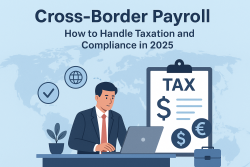
Cross-Border Payroll: How to Handle Taxation and Compliance in 2025
Managing payroll within one country is already a big responsibility, but when your business has employees working across different countries, things get even more complicated. Cross-border payroll means paying employees in multiple countries while following each country’s tax laws and compliance rules. In 2025, with more companies hiring globally, this topic is more important than ever.
Why Cross-Border Payroll Matters
When you hire international talent, you get access to skilled workers from anywhere in the world. But along with that comes the challenge of managing different tax systems, currencies, and labor laws. Mistakes in payroll can lead to penalties, unhappy employees, or even legal troubles. That’s why understanding taxation and compliance is key.
Key Challenges in Cross-Border Payroll
Here are some common hurdles companies face in 2025:
Different Tax Rules: Every country has its own tax structure. What works in the U.S. may not apply in India, Germany, or Canada.
Currency Exchange: Paying employees in their local currency means keeping an eye on exchange rates.
Compliance with Local Laws: From minimum wages to social security contributions, each country sets its own rules.
Data Security: Payroll involves sensitive information. International transfers must follow data protection laws like GDPR.
Remote Work Impact: With remote work becoming normal, employees might live in one country but work for a company in another, making payroll more complex.
How to Handle Taxation and Compliance in 2025
Here are some best practices businesses can follow:
Use Global Payroll Platforms
Modern payroll software can manage multiple countries’ rules, calculate taxes, and ensure employees are paid correctly.
Work with Local Experts
Partner with local accountants or payroll providers who know the country’s laws inside out.
Stay Updated on Regulations
Tax rules change often. Keeping track of updates helps you avoid mistakes.
Ensure Data Protection
Use secure systems to handle employee information and follow international data privacy regulations.
Plan for Remote Workers
Create clear policies for employees who work across borders to avoid tax confusion.
Final Thoughts
Cross-border payroll doesn’t have to be overwhelming. With the right tools, expert advice, and a clear strategy, businesses can pay their international teams smoothly while staying compliant. In 2025, companies that handle global payroll effectively will have a big advantage in attracting and keeping top talent worldwide.
